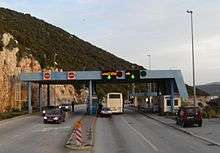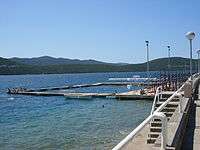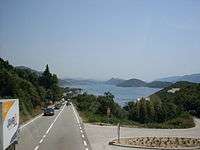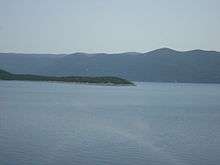Neum
| Neum Неум | |
|---|---|
|
| |
 Location of Neum municipality (shown in red) within Bosnia and Herzegovina | |
 Location of Neum (town) | |
| Coordinates: 42°55′30″N 17°37′00″E / 42.92500°N 17.61667°E | |
| Country | Bosnia and Herzegovina |
| Entity | Federation of Bosnia and Herzegovina |
| Canton | Herzegovina-Neretva |
| Municipality | Neum |
| Government | |
| • Municipality president | Živko Matuško (HDZ) |
| Area | |
| • Total | 225 km2 (87 sq mi) |
| Population (2013 census) | |
| • Total | 4,960 |
| • Density | 22/km2 (60/sq mi) |
| Time zone | CET (UTC+1) |
| • Summer (DST) | CEST (UTC+2) |
| Area code(s) | +387 36 |
| Website | http://www.neum.ba |
Neum (Serbo-Croatian pronunciation: [nɛ̌um], Cyrillic: Неум) is the only town to be situated along Bosnia and Herzegovina's 20 km (12 mi) of coastline,[1] making it the country's only access to the Adriatic Sea. In 2009 the municipal (općina) population was 4,605 and in 1991 the population of Neum town (naselje) was 4,268.
Features
Neum has steep hills, sandy beaches, and several large tourist hotels. Prices tend to be lower than in neighboring Croatia, making it popular with shoppers. Tourism, and the commerce it brings, is the leading contributor to the economy of the area. Border formalities with Croatia are relaxed at peak times.
Neum has around 5,000 beds for tourists, 1,810 in hotels with the remaining capacity in motels, villas, and in private accommodation. Tourism in Neum is active only in the coastal region. The inland area behind Neum has a rich archeological history and untouched wilderness and is starting to develop agricultural tourism.
Geography
Overview
Neum is 60 kilometers (37 mi) from Dubrovnik (80 km or 50 mi from the Dubrovnik Airport), 70 km (43 mi) from Mostar and Međugorje and 30 km (19 mi) from Ploče and Metković, both of which have railway stations.
The Neum region cuts Croatia into two non-contiguous parts. This is a result of the Treaty of Karlowitz of 1699.
The fact that the borders of Bosnia and Herzegovina must be crossed twice in order to reach the southernmost region of Croatia has caused the Croatian Government to plan a bridge from Klek to Pelješac to circumvent the area. Since this could potentially violate Bosnia-Herzegovinian rights under the International Law of the Sea, these plans have been put on hold until a mutually satisfactory solution can be reached.
Neum is planned to be a freight port. There are plans to build a real seaport, rail and a motorway and thus the Croatian bridge must have a high clearance according to the view of Bosnia and Herzegovina. The main freight port for Bosnia and Herzegovina today is Ploče (in Croatia) further north, which has a railway to Bosnia-Herzegovina.
Subdivision
The municipality includes the town of Neum (municipal seat) and several villages:
Babin Do, Borut, Brestica, Broćanac, Brštanica, Cerovica, Cerovo, Crnoglav, Dobri Do, Dobrovo, Donji Drijen, Donji Zelenikovac, Dubravica, Duži, Glumina, Gornje Hrasno, Gradac, Hotanj Hutovski, Hutovo, Kiševo, Moševići, Prapratnica, Previš, Rabrani, Vinine and Žukovica.
Border crossings

Neum has two border crossing checkpoints with Croatia on the European route E65 or Adriatic Highway which connects the two parts of Croatia's Dalmatian coast. Neum 1 is located to the northwest of the city, with the Klek border checkpoint on the Croatian side. Neum 2 is located to the southeast, with the Croatian border checkpoint at Zaton Doli.
History
The Neum corridor dates back to the Treaty of Sremski Karlovci of 1699, whereby the Republic of Ragusa was separated from the Dalmatian possessions of its rival Venice by two buffer strips ceded by Venice to the Ottoman empire: north of its territory Neum and the bay of Klek, and south of its territory Sutorina with the port of Herceg-Novi on the Bay of Kotor, now part of Montenegro since 1947.[2]
The Karlovci borders were reaffirmed in 1718 by the Treaty of Požarevac, but then the Ottomans, tired of negotiating in vain with Venice for a widening of their maritime access, simply usurped from the Republic of Ragusa the territory of Gornji Klek and most of the Klek peninsula, which it had bought from King Stjepan of Bosnia at the end of the 14th century. After the fall of the Venetian Republic in 1797 and the Vienna Congress in 1815, the Austrian Empire, which had annexed both the Dalmatian possessions of Venice and the territory of Dubrovnik, tried to buy back the Neum and Sutorina enclaves from the Ottomans, but in vain; instead, it stationed a warship to block access to the port of Neum until the Treaty of Berlin, which gave Vienna the whole of Bosnia-Herzegovina in 1878; Neum had been under Ottoman control for 179 years.
In 1918, as a consequence of Vienna's defeat, Neum joined the Kingdom of Serbs, Croats and Slovenes which would start being called "Yugoslavia" in 1929. Under the Karađorđevićes, the Yugoslav Government ignored the borders inherited from history twice: in 1929, when the Neum Region was included in a Banovina of the Coast, and in 1939 when, following the Serbian-Croatian Sporazum, it was included in the Banovina of Croatia. Tito's federal Yugoslavia was founded on the principle, declared at the 1943 AVNOJ in Jajce and comparatively well-respected by the Đilas commission in 1945, of establishing the federated Republics in their borders of 1878 which is why the Neum enclave is now part of the independent Republic of Bosnia-Herzegovina, including most of the Klek peninsula (Ponta Kleka, Rep Kleka), the two islets Veliki i Mali Školj and the rock of Lopata in the Bay of Klek.[3]

Climate
Neum has warm summers and mild winters.
The average sea temperature ranges from 13 °C (55 °F) in January to 28 °C (82 °F) in July and August. Popular activities include swimming and sun bathing, beach-going, boating, and various other water-sports.
Demographics
The municipality of Neum shrank in size from 1971 to 1991; it had 4,781 residents in 1971, and decreased to 4,268 twenty years later. According to the 1991 census, 87.6% of the residents were Croats, 4.9% Serbs, 4.39% Bosniaks and other nationalities. The actual town of Neum had 1,993 residents in 1991, with a higher (91%) proportion of Croats.
Culture

Neum celebrates the feast of Our Lady of Good Health as its municipal day. As part of the celebrations, Neum hosts the Music Festival Etnofest Neum. The town also hosts the Neum Animated Film Festival.[4]
The linđo is traditionally danced in the Neum region.[5]
Neum is home to local branches of the cultural organizations Matica hrvatska and HKD Napredak.[6][7]
Sport

Neum has a water polo club VK Jadran Neum, which is a member of the Croatian Water Polo Federation.
Neum gallery
 Adriatic coast of Bosnia-Herzegovina
Adriatic coast of Bosnia-Herzegovina View of Neum Bay
View of Neum Bay- Historical tombstones (Stećci) in Neum
- Resorts at the coast
 Klek peninsula
Klek peninsula_-_general_view.jpg) View of Neum
View of Neum
See also
- Sutorina
- Croats of Bosnia and Herzegovina
- Tourism in Bosnia and Herzegovina
- Bosnia and Herzegovina–Croatia relations
References
- ↑ Bosnia-and-Herzegovina Neum britannica.com, britannica.com, 2015-09-09
- ↑ The attribution of Sutorina and Herceg-Novi to the Republic of Montenegro in 1947, a departure from the principle of respecting the borders inherited from history affirmed by Tito in 1943, is rumored to be the consequence of a deal between Đuro Pucar and Blažo Jovanović (Source: "Neum i granični problemi" ("Neum and the border issues"), Poskok.info, December 14th, 2012)
- ↑ Source: "Neum i granični problemi", Poskok.info, December 14th, 2012
- ↑ Neum Animated Film Festival
- ↑ 50. Split Summer
- ↑ Matica hrvatska
- ↑ HKD Napredak
External links
| Wikimedia Commons has media related to Neum. |
- Future Port of Neum
- Bosnian Border Police
- Neum city portal / Neumski gradski portal
- Official website of Neum (In Croatian and English)
- Neum City info
- Neum City info
- Info and accommodation in Neum
Coordinates: 42°55′30″N 17°37′00″E / 42.92500°N 17.61667°E